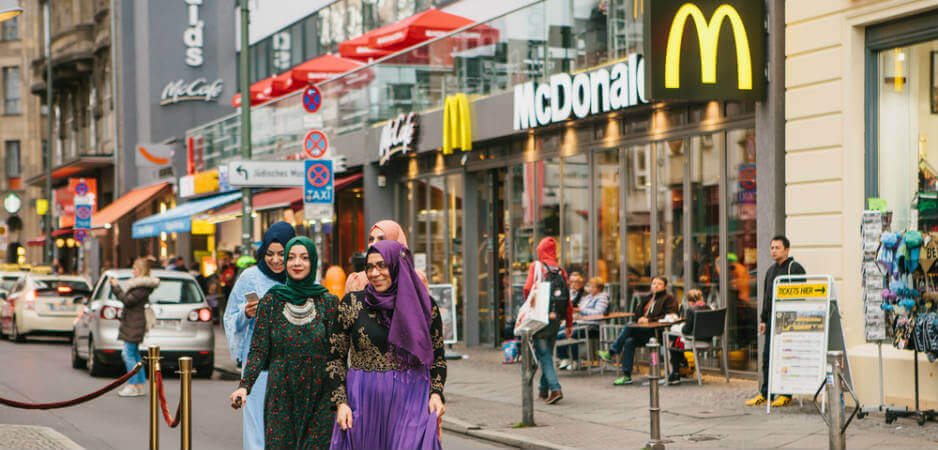If 25% of minorities are unwilling to accept the integration model of the state, then it is a crisis not only of integration, but of the national state itself.
It is commonly believed that the main reason for radicalism in Europe is the presence of entrenched xenophobic traditions of the majority versus minority, inadequate legislation on minorities and the increase in migration flows from Asia and Africa that create the demand for extreme-right policies from the indigenous populations. However, migration from developing countries into Europe has been present since the 1950s. In addition, radical Islamists are often second or third generation immigrants, born in Europe and fluent in the language of the country they live in.
It is therefore fair to say that the cause is more fundamental and lies in the self-determination and the readiness of minorities to respect the traditions of the majority and vice versa. Does this mean that traditions and legislation play a main role in this issue? Not necessarily. There is a whole range of influencing factors, including the type of integration model implemented by a country.
Most European countries, excluding Switzerland and, to some extent, Russia, have implemented an assimilation model of integration. This model allows members of any ethnic or religious minority to become French, Greek or Italian if they satisfy the strictly defined conditions for naturalization. In other words, to be a part of the French nation, a resident of the French Republic does not have to be French by ethnicity, but must be fluent in French, accept the history and culture of France as one’s own and feel an integral belonging to the country — to voluntarily assimilate.
The word “voluntarily” is key here. This does not mean that one has to forget one’s roots and native language. In France, for example, we find the descendants of Russian immigration of the 1920s who preserved the Russian language and their ancestors’ culture, but they were actually French in a cultural, linguistic and everyday sense of the word.
Integration Models
This model is still considered a major achievement of European democracy, an essential tool in the struggle against racial and religious discrimination. It is the result of a type of a nation state, a classical European model. It is based on the term “nation” as a community of people united by not only common land, but also a common supranational (supra-ethnic) cultural and historical identity, which is based on the traditions of the titular nation.
This is the reason why countries like France and Greece (excluding Western Thrace) do not recognize minorities at all — in their view, it would prevent their self-determination. Therefore, all citizens of France are considered French and all citizens of Greece, Greek. The same may be said about many other European countries, who refuse to recognize new national minorities, as the support of minority cultures, languages, education and so on (as required by the Framework Convention For The Protection Of National Minorities), as it contradicts the idea of assimilation and cultural self-identification.
In general, the European countries that recognize all minorities and ratify the Framework Convention without reservations also have the assimilatory integration model. Typically in these countries, there is one national language and, sometimes, several official regional languages belonging to traditional national minorities, there is no state support for schools, ethnic and religious minorities and so on.
For example, according to a 2012 report by the Council of the European Framework Convention for the Protection of National Minorities, in the United Kingdom the government supported only two Muslim schools — in Brent and Birmingham — considering these establishments sufficient for the demands of state education. Instead of establishing religious and national schools, the government implemented the policy of the “promotion of religious and cultural identity.” So, if a large amount of minority students wants to introduce halal meals, such meals are introduced for the whole school. Minority cultures are only studied by the minorities themselves.
All in all, Great Britain does not prevent minorities from education and self-realization; however, this is usually not funded by the state. The same can be said for the religious side of life. Generally, this model is supported by a vast majority of foreign nationals. However, this is no longer an absolute majority.
Voluntary Assimilation
The crisis arose as a result of the globalization process, when streams of immigrants poured into Europe unwilling to voluntarily assimilate. Tunisians in France wanted to stay Tunisians, not become French. In France, 25% of Muslims do not want to accept the European model of integration. This figure is not very different among the Christian immigrants from the developing world. The situation is similar in other European countries. It is a large figure. In other words, a quarter of immigrants from developing countries consider themselves nationals of their original countries or ethnicities — Muslims, Arabs, Turks or Pakistanis — not French, Greek or Italian.
Yes, they enjoy living in these countries where their children are born, and they are ready to accept themselves as citizens of France or Germany, but not as French and Germans. This is particularly relevant with respect to people who were born in these countries, who even consider themselves European, but with a completely different identity that has nothing in common with European traditions. However, European traditional national states, despite claims of commitments to the ideals of multiculturalism, are not ready to accept the new reality.
If 25% of minorities are unwilling to accept the integration model of the state, then it is a crisis not only of integration, but also the national state itself. Ancient European traditions upon which the nation states were founded came into conflict with the modern reality and the unwillingness to respect these traditions as a significant part of “new” minorities.
Herein lie the foundations of the conflict. Members of national and religious minorities, an increasing number of whom are unwilling to assimilate, demand their national-cultural and religious rights to be observed by the state, which denies them on the basis that their minority does not officially exist in the country. As a result, this area is usually dominated by radicals, such as Islamists.
However, a significant section of this 25% is not just rejecting assimilation. These minorities are seeking to impose their own civilizational model on the majority. Governments are welcoming this with their integration policies, for example by introducing halal meals or demanding a “more modest” uniform dress code in schools to accommodate Muslim students. This also manifests in the refusal of some city councils to set up Christmas trees in city centers or discouraging the sale of pork and alcohol in certain markets.
Some governments have a completely opposite reaction, no less harmful, which is an attempt to repress the national-cultural development of minorities. Greece is a good example of this, having tried to prohibit the reading of the Koran in Turkish minority schools and appoint Islamic leaders without consulting the community itself.
Irredenta
Both of these approaches only breed tension and protest of either minority or majority. The resulting conflict leads to radical nationalism and extremism. The situation became more complicated in post-Soviet countries that have irredentas. There is a difference between the term “diaspora” and “irredenta.” American sociologist Rogers Brubaker uses the term “accidental diasporas” and differentiates between the terms “movement of peoples across borders” and “movements of borders across peoples.”
Irredenta (from the Italian irredentismo — unredeemed), or irredenta nation is used to describe ethnic minorities inhabiting the territory adjacent to the country dominated by their compatriots. An unredeemed nation is left beyond the borders of its country following wars, annexations, border disputes or as a result of various colonial models — in this case, the fall of the Soviet Union.
Unlike a diaspora whose members are scattered throughout the territories far from their historical homeland, members of irredenta are compactly settled in countries bordering their historical homeland, with particularly high concentrations in the border adjacent regions. The main feature of irredenta is its large numbers on a relatively low level of internal consolidation.
Irredenta are usually sensitive to any infringement of the majority on their rights, since they consider themselves autochthonous inhabitants of the territory they occupy. These groups continue to regard themselves as part of the majority. They are particularly sensitive to relations between their country of residence and their historical homeland. If discrimination takes on a systematic character, irredenta form a movement for the reunification with the territory of the ethnic majority — irredentism. A similar situation arose in Ukraine, which currently tries to implement the European model of a nation state based on the formation of a nation grounded in the traditions of the titular ethnos. Events in Crimea and in the southeast of Ukraine are primarily a result of this process.
Crisis of Tradition
The crisis of a traditional European nation state has been a long-term problem, where globalization and intense migration flow caused a contradiction between the traditions and principles that founded European nation states in the mid-19th century and expectations of a significant section of national and religious minorities living on this territory. Is there a solution to this crisis? Certainly there is.
As is known, an assimilation model of integration could be replaced with a multicultural model, which recognizes the equality of cultures and allows for changes of the hosting society under the influence of new arriving cultures. However, attempts to implement such models in the 1990s have failed, largely because of contradictions between the multicultural model and the European model of a nation state. Therefore, the only alternative is changing the type of nation state.
A state built on the traditions of a titular nation can be transformed into an international state, based on a fundamental unifying idea. For example, the establishment of the United States was based on the Protestant messianic idea of exploration and democracy. A new American nation was created on the basis of this ideology and a universal mythological immigrant state.
The Swiss nation was based on the idea of neutrality. In 1291, three cantons populated by different, primarily Germanic, ethnic groups united to defend themselves against Austrians, Burgundians and other troublesome neighbors. In 1513, they were joined by 10 more cantons (currently there are 26). For a small country surrounded by large, constantly warring states, neutrality guaranteed safety and allowed the Swiss to play an important role on the world arena.
The notion of class — the idea of the “dictatorship of the proletariat” and proletarian internationalism — united almost all lands of the disintegrated Russian Empire and created the Soviet Union. Over the years, the USSR almost concluded the process of creating a new multi-ethnic nation, or as it was then called “a new historical community — the Soviet people.” The idea then lost popularity, was discredited and substituted in several Soviet republics with nationalist ideas, which along with objective destructive processes characteristic for all of the empires, largely contributed to the collapse of the Soviet Union.
Conventionally, a state established around a unifying idea can be called international, since it is not created around the traditions of a particular titular ethnic group. The new unifying ideas can be very different. One of them is the European idea, or the idea of European federalism, which is currently being attempted in the European Union. Another idea — realized by Russia and Kazakhstan — is that of the Eurasian confederation. Internationalism can be implemented within one country. Russia serves as an example in this regard having generally accepted an internationalist idea based on the cooperation of peoples living on its land. Its national republics — Tatarstan, Bashkortostan, Chechnya and so on — have their national languages recognized on an official level (as second state languages), and the rights of all of the national minorities, of which there are more than 100, are guaranteed.
However, the influx of Central Asian immigrants in Russia reaccentuates the issue that this list is ever expandable. Russia will then face the challenge of fully converting to an international model of state or face the difficulties encountered by European states today.
Identity Change
Changing the type of nation state is an extremely painful process, as it presumes a change of identity of both majorities and minorities, including those individuals who try to impose their civilizational model on the majority. This process would be easier for the former Soviet republics, as they have recent experience of living in an international state. EU countries will find this process more challenging as their model has stood for centuries, and it is different.
This is why the European idea, the ultimate aim of which is the change of individual national identities to a common European identity — multicultural and multireligious — causes so much protest among the nationalist Eurosceptics. Their proposed alternative is the further expansion of nationalistic tendencies, a weakening of European institutions, the disintegration of Europe and a return to the classic model of the state, which includes the assimilation of foreign nationals. However, in the current climate, this policy is a dead end, as the number of foreign nationals to be assimilated will continue to grow, and these people hold different ideological views (especially in social isolation). Forced assimilation in these conditions is unlikely, given the number of subjects, their mutual solidarity and their mistrust or even hostility toward the majority. Such an experiment may result in the most unexpected and harmful of consequences, including the rise of extremism in Europe.
European xenophobia is the result of fundamental historical traditions and miscalculations in modern legislation. However, both of these factors are related to the obsolete model of European nation states, built on the traditions of titular nations and allowing for only one type of minority integration — through assimilation. The rejection of assimilation among a significant and constantly growing portion of minorities in Europe leads to the crisis of the nation state, which manifests as a conflict between the founding principles of the state and the rejection (or revision) of such principles by minority groups. These conflicts accumulate in the form of xenophobic sentiments between both groups, which then leads to hate crime, as well as inter-ethnic and inter-religious tensions in Europe.
The growth of aggressive nationalism and xenophobia in Europe, especially considering the impressive influx of asylum seekers from the Middle East, has gradually become alarmingly problematic, and is an issue that will soon face the entire continent. It endangers not only the current model of the nation state but also the prospects for European integration and, most importantly, the identity of many European countries formed over the centuries.
*[Centre for Analysis of the Radical Right (CARR) is a partner institution of Fair Observer.]
The views expressed in this article are the author’s own and do not necessarily reflect Fair Observer’s editorial policy.
Photo Credit: franz12 / Shutterstock.com
Support Fair Observer
We rely on your support for our independence, diversity and quality.
For more than 10 years, Fair Observer has been free, fair and independent. No billionaire owns us, no advertisers control us. We are a reader-supported nonprofit. Unlike many other publications, we keep our content free for readers regardless of where they live or whether they can afford to pay. We have no paywalls and no ads.
In the post-truth era of fake news, echo chambers and filter bubbles, we publish a plurality of perspectives from around the world. Anyone can publish with us, but everyone goes through a rigorous editorial process. So, you get fact-checked, well-reasoned content instead of noise.
We publish 2,500+ voices from 90+ countries. We also conduct education and training programs
on subjects ranging from digital media and journalism to writing and critical thinking. This
doesn’t come cheap. Servers, editors, trainers and web developers cost
money.
Please consider supporting us on a regular basis as a recurring donor or a
sustaining member.
Will you support FO’s journalism?
We rely on your support for our independence, diversity and quality.








